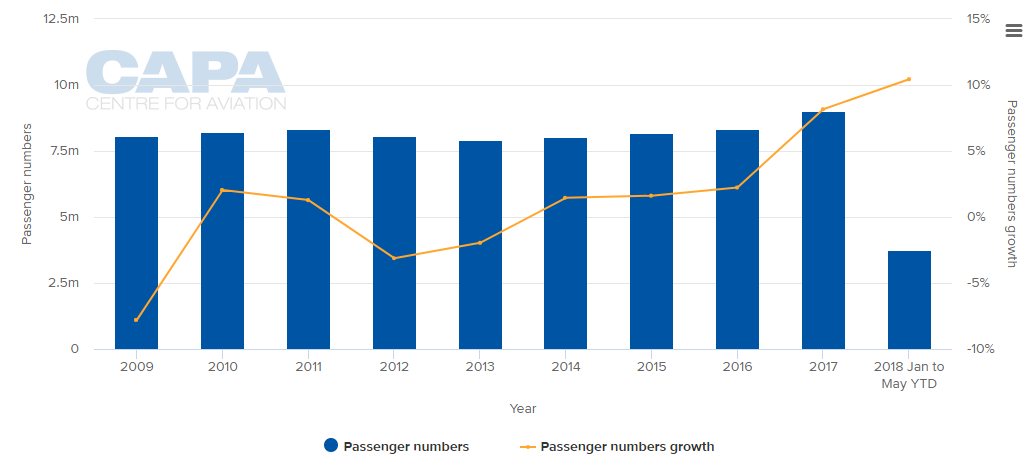Summary:
- Improved service to the US west coast has been a big focus for Pittsburgh International Airport as it attempts to colour its network white spots;
- Traffic levels at the airport are growing at high levels, up +8.2% in 2017 and already up +10.4% across the first five months of this year;
- Seasonal frequency additions and more available seats to top business and leisure markets nonstop are the main reasons for the traffic growth highs;
- A highlight for the remainder of the year will be the introduction of a small schedule of nonstop charter services to Shanghai with China Eastern Airlines.
At that time, Ms Cassotis stated that gaps in west coast coverage were frustrating for the airport's passengers, who were working to take advantage of spin-offs from Carnegie Mellon and the University of Pittsburgh. She cited the growing high tech community in the Pittsburgh area and many companies from the Silicon Valley and Seattle that were basing operations in Pittsburgh. Large technology companies Google, Uber and Facebook all have a presence in the Pittsburgh region.
The airport secured a key victory in filling west coast service gaps when Alaska Airlines outlined plans to launch service between Pittsburgh and Seattle in Sep-2018. Pittsburgh is a finalist in the competition for Amazon's second headquarters, and a link to Seattle certainly does not hurt the city's chances in the competition.
More recently, United has stated that it plans to expand service between Pittsburgh and its hub in San Francisco. Previously, the airline implemented a hiatus on the route in Jan and Feb but will now operate the flight year-round, and plans to add a second daily flight on the pairing from Jan through Oct.
During the past year Spirit Airlines has joined Southwest in operating service from Pittsburgh to Los Angeles, filling a service gap created by American when it cut service on the pairing in early 2017.
This all adds to numerous domestic and international new route successes that is helping to drive passenger growth at Pittsburgh International Airport and support its turnaround since US Airways closed its Pittsburgh hub in 2004. It has been a period of ups and downs since then with growth at the start of the current decade preceding two years of traffic declines in 2012 and 2013. Modest year-on-year growth returned in 2014 and 2015 before reaching a then decade high of +2.2% in 2016.
But since then things have been on the rise. Traffic levels shot up to a new clear decade high rate in 2017 with passenger numbers up +8.2% and this year are even out performing that rate at +10.4% across the first five months of the year. This puts the airport on track to potentially pass the ten million passenger milestone for the full year - it ended 2017 handling 8.9 million passengers.
CHART - Traffic levels at Pittsburgh International Airport grew at a decade high rate in 2017, but levels are running still higher across the first five months of 2018 Source: CAPA - Centre for Aviation and OAG
Source: CAPA - Centre for Aviation and OAG
Seasonal frequency additions and more available seats to top business and leisure markets nonstop from Pittsburgh International Airport are the main reason passenger traffic is growing to these new highs. In May, passenger traffic was up +8.6% as 841,092 passengers travelled through the airport, making this month the busiest May for travel in over a decade and marking the 25th consecutive month of passenger growth.
"Making travel easier for passengers is as important as adding new dots to the map," says Ms Cassotis. "Frequency additions and larger planes on established routes are indicative of demand in Pittsburgh's healthy and growing market."
In addition to resumption of international service on Condor and Delta Air Lines in May-2018, airlines have added capacity for the peak summer travel season to the following markets: Nashville on Southwest; Boston on Delta and JetBlue; Dallas/Fort Worth on Spirit and American; Myrtle Beach on Spirit; and Las Vegas on Southwest, all contributing to growth in seats, flights and passengers for the month.
Also in May-2018, WOW air resumed a fifth weekly flight to Reykjavik, Air Canada began nonstop service to Montreal, Vacation Express began weekly charter service to Cozumel, and Delta and American continued weekend scheduled service to Cancun. More recently a new nonstop service to Salt Lake City on Delta began earlier this month.
A highlight for the remainder of the year will be the introduction of a small schedule of nonstop charter services to Shanghai with China Eastern Airlines as part of a historic partnership agreement between Pittsburgh International Airport, VisitPittsburgh, Idea Foundry and Caissa Touristic. The services will be flown using a 316-seat Boeing 777-300ER and begin from 03-Aug-2018.
Alongside a longer series of flights to China, Ms Cassotis highlighted the UK and Germany as key growth markets for the future. She told CAPA TV during a recent interview that the growth being recorded in 2017 and year to date highlights room for further network expansion. "It tells me that we still have more air service to absorb," she explained.
Having now enjoyed two full years of monthly traffic rises, Ms Cassotis highlights how the airport has emerged from the shadows after losing its hub status and how it is working with airline partners to explore a collaborative approach to development across multiple operational models. She highlights work being doing ahead of the arrival of its first Chinese leisure link later this year and how digitalisation will play an important part in its roadmap for the future.